Acoustic Democracy : Montreal’s New Symphony Hall by Wah Keung Chan
/ September 1, 2011
Version française...
Flash version here
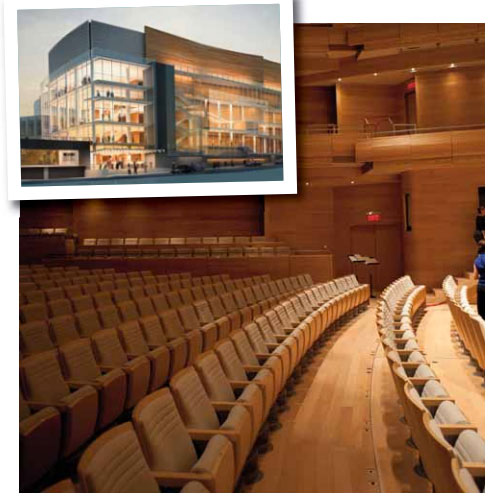 The long wait is over.
After almost 30 years, Montreal finally has its own symphony hall. On
August 26, 2011, the Montreal Symphony Orchestra held its first rehearsal
in the new hall for the eagerly anticipated inaugural concert on September
7. This yet-to-be-named hall on the northeast corner of Place des Arts
signals a new chapter in the history of music in Montreal and Canada. The long wait is over.
After almost 30 years, Montreal finally has its own symphony hall. On
August 26, 2011, the Montreal Symphony Orchestra held its first rehearsal
in the new hall for the eagerly anticipated inaugural concert on September
7. This yet-to-be-named hall on the northeast corner of Place des Arts
signals a new chapter in the history of music in Montreal and Canada.
Blond Quebec beech wood envelops its
interior and Casavant organ pipes hang above the stage: it is a thing
of beauty. The big question, however, is how will it sound? Although
it’s still too early to say, based upon the design and the track record
of the building team, the hall will most likely succeed in being beautiful
in both sound and appearance.
Behind the scenes
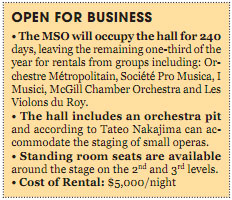 When the provincial Liberals
took power in 2003, they scrapped the previous concert hall project
in favour of a public-private partnership (PPP) scheme. Perhaps it was
the prospect of being able to play ppp (pianississimo) in a new
hall that helped entice maestro Kent Nagano to accept the MSO’s artistic
directorship in 2004, as one of the first things he did was to recommend
that Artec Consultants be hired as the hall’s acoustic designers.
“We began with a basic design based on the shoebox of traditional
concert halls, where the walls and seats are,” explained Tateo Nakajima,
a partner at Artec. When the provincial Liberals
took power in 2003, they scrapped the previous concert hall project
in favour of a public-private partnership (PPP) scheme. Perhaps it was
the prospect of being able to play ppp (pianississimo) in a new
hall that helped entice maestro Kent Nagano to accept the MSO’s artistic
directorship in 2004, as one of the first things he did was to recommend
that Artec Consultants be hired as the hall’s acoustic designers.
“We began with a basic design based on the shoebox of traditional
concert halls, where the walls and seats are,” explained Tateo Nakajima,
a partner at Artec.
In many ways, the new hall has Nagano
written all over it. The closeness of the stage to the audience was
something he recommended with the Amsterdam Concertgebouw as inspiration,
Nagano told LSM at a site visit last October. While many of Artec’s
halls in Canada (Windspear in Edmonton and Toronto’s Roy Thomson Hall)
sport an adjustable circular wooden canopy directly over the stage,
Nagano chose the system of adjustable rectangular reflectors/canopies
that integrate with the ceiling above the audience as well. “Back
in 2004, we were presented with a vision that [Nagano] had for the hall,
its role in the community, and a vision for the orchestra and its repertoire,”
said Nakajima, adding, “It has really been at the foundation of the
basic design we developed. Periodically, he’s been consulted and he’s
approved what’s developed. He was involved in discussions, and reiterated
and reinforced certain aspects of what he wanted to see.”
Nakajima’s design was refined by the
Quebec government and then put out for tender in a competition for an
architect builder consortium, a process that took another two years.
Before the selection, Nakajima met with each contender in a series of
controlled government-supervised meetings. The winning architect was
Jack Diamond, of the same firm (Diamond and Schmitt Architects) that
designed Toronto’s acclaimed Four Seasons Centre for the Performing
Arts, home of the Canadian Opera Company. It seemed a strange decision
as the two companies had never worked together before, and, naturally,
Diamond had his own acoustic consultant before winning the contract.
“The process was that they would propose something and we could find
a way to make it work or not,” said Nakajima. “Their desires were
primarily either architecturally or financially driven. Ultimately,
Artec is to be held completely responsible for the acoustics and theatre
planning, and we were not going to give up one iota of decision-making.”
In a shoebox
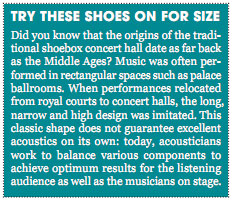 The 2,990-seat Salle Wilfrid-Pelletier, home
of the MSO since it opened in 1963, was designed as a multipurpose auditorium—as
was the vogue then—and was never known for great acoustics. Artec
founder, the late, Russell Johnson was consulted on its acoustics at
the time and the Place des Arts board had wanted him to build a 5,000-seat
hall. “Russell spent a year to convince them that an orchestra would
not sound good in such a large room,” Nakajima said. Although the
hall was renovated in the 1990s with the installation of all-wood paneling
surrounding the stage, the improvements were not enough. “With the
noise of the air conditioning and the buzz of the lights, it’s impossible
for the audience to hear a real pianissimo,” Nagano noted. The 2,990-seat Salle Wilfrid-Pelletier, home
of the MSO since it opened in 1963, was designed as a multipurpose auditorium—as
was the vogue then—and was never known for great acoustics. Artec
founder, the late, Russell Johnson was consulted on its acoustics at
the time and the Place des Arts board had wanted him to build a 5,000-seat
hall. “Russell spent a year to convince them that an orchestra would
not sound good in such a large room,” Nakajima said. Although the
hall was renovated in the 1990s with the installation of all-wood paneling
surrounding the stage, the improvements were not enough. “With the
noise of the air conditioning and the buzz of the lights, it’s impossible
for the audience to hear a real pianissimo,” Nagano noted.
The key to the acoustic success of the
new hall is the Artec specification that it meets their “N1” criterion
of outside noise, which means that the room is isolated from the outside.
Diamond’s solution was to build the hall balanced on rubber pads,
as a shell separate from the outside foundation, one of the best features
of the Toronto opera house. “We found a new way to isolate the hall
and to do it in one metre instead of the usual three metres,” explained
Jack Diamond proudly during a site visit this past June. “The difference
is that trucking can come in at platform level and we can unload the
piano and instruments straight onto the stage.”
Surprisingly, the new hall, with 1,900
seats (2,100 without a choir), is only slightly smaller in volume than
the Salle Wilfrid-Pelletier, according to Matthew Lella, project architect
at Diamond-Schmitt Architects. “The main difference is that this room
is much narrower., That is what will create the initial clarity of sound
and the warmth of the reverberation.”
The other big difference is the overhead
adjustable canopy system, which was the most time-consuming part of
the installation due to its complexity. “The visual and aesthetic
relationship of the canopies to the hall is reminiscent of São Paulo,”
said Nakajima. “They have a full ceiling system, this is a two-thirds
ceiling system.” This means that two-thirds of the panels move, changing
the dimensions of the initial reflective surfaces, as well as the
secondary volume spaces. “In a big room, sound can come from further
back; if it is too loud, it appears as an echo. When we move the canopies,
it’s a combination of bringing initial sound faster to people and
how much energy is going into a secondary part of the room that ultimately
has to blend and come back to you and let your mind interpret as one
sound. There is some repertoire that wants a bigger, broader and more
supported environment. Some want to be thinned out in terms of sound,
while others [have] harmonic changes that can deal with fuller, longer
reverberation. There is a difference between a chamber group and a larger
ensemble.”
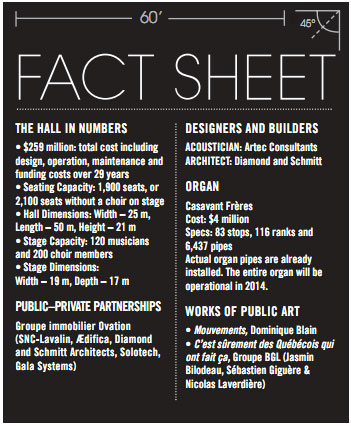 In the days before September 7, Nakajima
will be doing extensive testing with Nagano and the orchestra to get
ready for opening night. “The goal after the first 12 months is to
come up with a discrete set of settings that form a good starting point
for usage that doesn’t require everyone to worry about it every time
and that broadly fit the major types of ensemble sizes that exist,”
Nakajima said. “We are not going to fit one for each movement. In
Miami, we have six settings. In Lucerne, where they love adjusting,
we have 16. This is primarily an artistic process that is supported
by the technical staff.” In the days before September 7, Nakajima
will be doing extensive testing with Nagano and the orchestra to get
ready for opening night. “The goal after the first 12 months is to
come up with a discrete set of settings that form a good starting point
for usage that doesn’t require everyone to worry about it every time
and that broadly fit the major types of ensemble sizes that exist,”
Nakajima said. “We are not going to fit one for each movement. In
Miami, we have six settings. In Lucerne, where they love adjusting,
we have 16. This is primarily an artistic process that is supported
by the technical staff.”
Many designers try to equate the absorption
of the seats to that of people, but Artec’s philosophy is to minimize
the amount of absorption in the room; they want little absorption in
the seats, which rationalizes the hard-back, hard-bottom seats. “The
top of the seat can be used as a handrail when you walk out,” Nakajima
explained, “and the mechanism has to be quiet.” During rehearsals,
cloth curtains can be used to help simulate the presence of an audience.
To eliminate air-conditioning noise,
the architect came up with round holes at the base of each seat. “The
air comes up from there,” Diamond explained. “It’s slow moving
air, big volume, so you don’t hear or feel it.”
There are many other architectural features
that serve to enhance the new hall’s acoustics. “This is a contemporary
example of a classic shoebox,” said Diamond. “The original shoeboxes
had a lot of decoration, angels, columns and so forth, which acted functionally
to disperse the sound. We don’t have this in a contemporary hall,
so we do it with the curvatures and the textures of the wall.” How
smooth the wood is, the balcony front, and the banding made with plaster
molds are just some features that affect the diffusion of the sound.
“The idea was to get that sense of
enclosure,” Diamond said. “The stage is surrounded by the audience,
so there is an intimacy between the audience and the players. All of
that to say that you have to mold the acoustic demands into an architectural
expression that works as a room. You should feel comfortable and relaxed,
not distracted by crazy moves in the architecture. It should be interesting
and powerful, but calm and enclosing.”
So which seat has the best sound? According
to Diamond, “It’s a democratic hall. Every seat has the same sound
density.” But Nakajima is more realistic, “Physically, it is impossible
to have the same [sound in each seat]. The walls are in different places
and you are seated in different geometry from the musicians. The reality
is that every seat is going to be different, but our goal is to have
a very high quality of experience everywhere that is not dramatically
different from each other.”
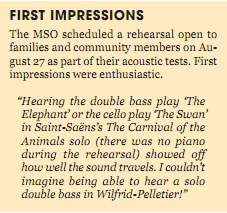 All roads lead to... All roads lead to...
You can’t fault Diamond for
getting carried away, because it is precisely the idea of a democratic
hall that is evident throughout the architectural design; this is what
probably won him the contract. “When the concert is on, the musicians
are the performers,” said Diamond. “During intermission, in the
public areas, the people are the performers. They see their friends,
they are moving. We are able to see down to the entrance of Saint Urbain
and see up to every level, so all the levels of the hall in the public
areas are visually connected, and you can also see out.”
Drivers may wonder why westbound de Maisonneuve
Boulevard was recently transformed from a diagonal street to right angle
intersections bordering a new park square. This is part of Diamond’s
design. “As you come west along de Maisonnneuve, this building is
the visual terminus, so it is given an importance that the other buildings
in Place des Arts do not have. And on that target’s bull’s-eye,
we’ve created a very special spot where a sculpture will be hanging
in structural glass. That’s the VIP lounge that sits on the axis with
the vista,” said Diamond. “One of the main entrances is right on
Saint Urbain, an urban entrance. The accessibility, again along the
democratic theme, allows people to come by subway, park below, come
by bus, or walk in off the street, from the concourse level or the plaza
level. We’ve got escalators for the handicapped.”
Diamond emphasized inclusion. “When
Place des Arts was built, isolated cultural precincts was the rage.
I think we now want to see a much greater level of integration between
the elements of the city and the street, and this accomplishes that.
Because of the transparency, it removes the sense of elitism of a closed
room.”
osm.ca
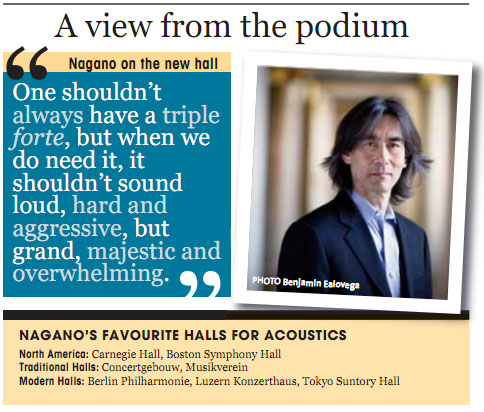
Version française... |
|


